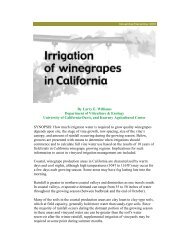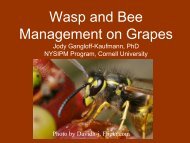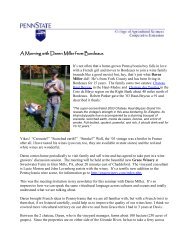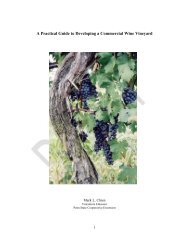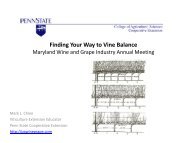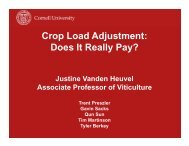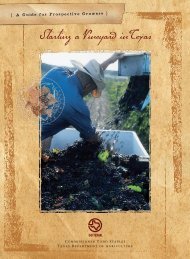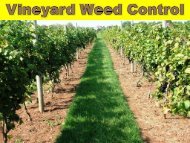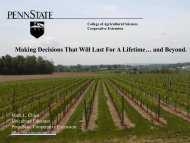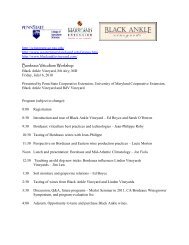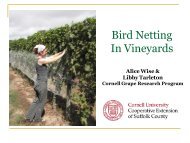Post Modern Winemaking_Clark Smith.pdf - PA Wine Grape ...
Post Modern Winemaking_Clark Smith.pdf - PA Wine Grape ...
Post Modern Winemaking_Clark Smith.pdf - PA Wine Grape ...
Create successful ePaper yourself
Turn your PDF publications into a flip-book with our unique Google optimized e-Paper software.
<strong>Wine</strong>s & Vines - Vineyard Enology: The Power of Showing Up<br />
http://www.winesandvines.com/sections/printout_article.cfm?article=column&content=74762<br />
Page 3 of 6<br />
7/6/2010<br />
Shift to Cycle Two. Click image to enlarge.<br />
All of the following vineyard conditions must be present in moderation in relation to soil type:<br />
water availability, incident light, canopy temperature, air movement and nutrient status. For<br />
example, too little sunlight shuts down color and flavor development, but too much causes<br />
sunburn. Too little air movement leads to rot, but too much wind results in stomatal closure<br />
and shutdown of sugar transport. Each of these aspects affects all the others. A shot of fertilizer<br />
results in more canopy, less light, higher temperatures, less air movement and increased soil<br />
water depletion.<br />
In the irrigated vineyards of the American West, the midseason steering wheel for vine balance<br />
is irrigation control. Leaf water potential is a preferred tool for gauging water availability,<br />
because it makes no assumptions about soil water tension and instead simply asks the vine<br />
itself. This technique is equally valuable as a diagnostic tool in unirrigated vineyards in the<br />
American East and in Europe.<br />
To measure LWP, a young leaf is taken at solar noon and placed in a pressure chamber with its<br />
petiole emerging through a gasket. Gas pressure is then applied until a sap bead appears,<br />
duplicating the force with which water is being drawn from the soil. Vines with access to free<br />
water read at minus-10 bars or less.<br />
A reading of minus-12 to minus-14 bars at veraison is desirable in promoting the transition to<br />
cycle two. This is before tendrils and other canopy indicators will show water stress signs,<br />
which set in over minus-14 bars in most cultivars. A reading of minus-17 bars marks the<br />
permanent wilt point and is believed to trigger stomatal closure.<br />
Water tension management has been shown to be most effective prior to veraison. Late-season<br />
water stress has little beneficial effect on color and flavor development, and it can lead to<br />
stressed flavors such as black pepper, and to field oxidation and fruit deterioration.<br />
Marks of maturity





